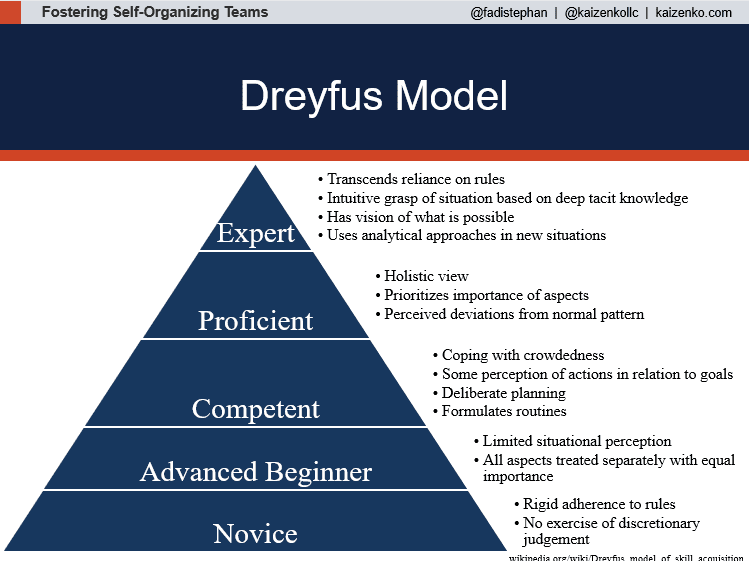The Dreyfus model of skills acquisition by brothers Stuart and Huber Dreyfus covers covers a similar concept as the 3 step ShuHaRi but uses 5 stages instead from novice to expert. The stages follows a progression from rigid adherence to rules to an intuitive mode of reasoning based ontacit knowledge.
Michael Eraut summarized the five stages of increasing skill as follows:
1. Novice
- “rigid adherence to taught
rules or plans” - no exercise of “discretionary
judgment”
2. Advanced beginner
- limited “situational
perception” - all aspects of work treated
separately with equal importance
3. Competent
- “coping with crowdedness”
(multiple activities, accumulation of information) - some perception of actions in
relation to goals - deliberate planning
- formulates routines
4. Proficient
- holistic view of situation
- prioritizes importance of aspects
- “perceives deviations from the
normal pattern” - employs maxims
for guidance, with meanings that adapt to the situation at hand
5. Expert
- transcends reliance on rules,
guidelines, and maxims - “intuitive grasp of situations
based on deep, tacit understanding” - has “vision of what is
possible” - uses “analytical
approaches” in new situations or in case of problems
https://pdfs.semanticscholar.org/03b9/d72b156c45b4855d300b28181e75e70bad5a.pdf

The model is based on four binary qualities:
- Recollection (non-situational or situational)
- Recognition (decomposed or holistic)
- Decision (analytical or intuitive)
- Awareness (monitoring or absorbed)
The fundamental idea is that when teaching a concept, you have to tailor the style of teaching to where the learner is in their understanding and that progression follows a common pattern. Early stages of learning focus on concrete steps to imitate, the focus then shifts to understanding principles and finally into self-directed innovation. The skill level is tied to a mental function transitioning from recollection (non-situational or situational), recognition (decomposed or holistic), decision (analytical or intuitive), and awareness (monitoring or absorbed)

This leads to Situational Leadership where the leader’s leadership style and approach needs to chang based on the type of follower you are working with. Let’s looks at that next.
Learn more about the Dreyfus Model in the Building High Performing Teams Workshop.
Also check out the complete Fostering Self-organizing Teams series:
- What is a Self-organizing Team?
- Scrum Magic! Do Scrum – Become Hype-productive!
- 3 Models for Skills Acquisition
- Shu Ha Ri
- The Dreyfus Model of Skills Acquisition
- Situational Leadership
- Tuckman’s Stages of Group Development
- Drexler/Sibbet Team Performance Model
- The ScrumMaster’s Role is Fostering a High Performing Self-Organizing Team
- 7 Attributes of a Self-Organizing Team
- Delegation Board for Fostering a Self-Organizing Team
- The ScrumMaster’s Progressive Delegation Responsibility
- Fostering Self-Organizing Teams Presentation